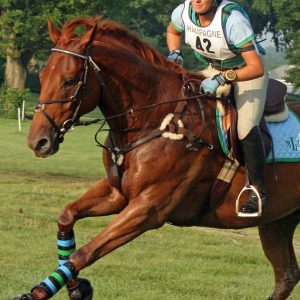
Nutrition’s Role in Horse Healing and Recovery
As equine athletes, our horses constantly run the risk of injury. When injury occurs, the horse is faced with a new set of challenges to overcome. Changes in exercise, diet and turnout place extra physical and mental stresses on the horse above and beyond those caused by the initial injury. The addition of targeted nutrients goes a long way toward helping the horse meet these challenges and recover faster.
Targeted supplements support essential systems during recovery.
1) Sustain a well-balanced digestive tract.
Goal: Enhancing immune function and protecting against digestive imbalances that lead to complications
Challenge:
Injured horses are often faced with immediate and substantial changes in their diet and routine that put the GI tract at high risk for imbalances. Antibiotics and NSAIDs further increase the stress on the digestive tract. A GI tract that is stressed and out of balance is at increased risk of developing colic, diarrhea, laminitis and ulcers. The gut also plays a significant role in the immune system of the horse. Poor gut health decreases the horse’s ability to mount a strong immune response, which can leave an individual open to secondary infection and slow healing.
Solution: Neigh-Lox® Advanced
The active ingredients found in Neigh-Lox Advanced—Saccharomyces boulardii (probiotic), fermentation metabolites (prebiotics), gastric buffers, and gastric coating agents—help maintain a healthy digestive tract in horses that are under stress. These ingredients support the GI tract by maintaining optimal pH levels in the stomach, intestines and hindgut. They sustain healthy tissue, support the healing of damaged tissue, and nourish beneficial microbial populations. Horses with a healthy digestive tract utilize their feed more efficiently, have a hearty appetite and a stronger immune response, and are at less risk of digestive upsets that lead to serious episodes of colic, diarrhea, laminitis and ulcers.
Recommendations:
Immediately begin supplementation with Neigh-Lox Advanced at a rate of 2 scoops ( 4 ounces) two times per day: once with the morning meal and once with the evening meal. If a horse is prescribed NSAIDs and/or antibiotics, a third meal of 2 scoops can be offered at night. Provide the injured horse with good quality fiber 24/7. If need be, use slow feeding devices or offer multiple meals during the day. Not only will fiber support a healthy digestive tract, but it will help decrease boredom. Limit concentrates as needed; if feeding less than the recommended amount of concentrate, supplement with a vitamin and mineral pellet. Consider molasses-free beet pulp as a healthy carrier for supplements and drugs. Provide free-choice white salt block and unlimited clean water at all times.
2) Maintain strong bones.
Goal: Maintaining optimal bone density and encouraging healing
Challenge:
Research has revealed that one of the keys to healthy bone formation is exercise. Exercise stresses the bone and stimulates bone remodeling, which in turn replaces damaged bone, repairs microdamage, and maintains bone density. When horses are kept in stalls due to injury, the stress on the bones is insufficient to maintain optimal bone remodeling and bone density is quickly lost. Microdamage that is repaired too slowly or left unrepaired is a precursor to more severe injuries once a horse resumes a more normal lifestyle. Confined horses that are recovering from soft tissue damage or skeletal injuries are put at increased risk for additional lameness and injury due to a reduction in bone density.
Solution: BoneWiseTM
In order for bone remodeling to take place during a layup period, the horse needs an adequate supply of readily available calcium and a host of trace minerals and vitamins, including boron, silicon and vitamin D. BoneWise contains a unique source of calcium and trace minerals that are readily absorbed by the horse. It supplies all the nutrients, including vitamin D, needed to maintain optimal levels of bone density when horses are most at risk for bone loss.
Recommendation:
Supplement with BoneWise at a rate of 2 ounces, two times per day.
3) Support healthy muscle and nerve function.
Goal: Speeding healing and reducing layup time
Challenge: Inadequate levels of vitamin E can impair immune, nerve and muscle functions, thereby slowing healing. Vitamin E is a powerful antioxidant that limits the damage caused by oxidative stress and the actions of free radicals at the cellular level. Horses with injuries can have higher requirements than otherwise normal horses because of increased oxidative stress and the demands placed on the immune system. Vitamin E cannot be synthesized by the horse; therefore, it is considered an essential nutrient. The best source of vitamin E is fresh green grass; however, the potency of vitamin E declines very quickly once forages are harvested and dried. Multiple research studies have shown that vitamin E is often deficient in the diets of horses that do not have access to continual grazing on fresh green grass, as is the case with many layups.
Solution: Elevate® W.S. (fast-acting natural vitamin E) orElevate® Maintenance Powder (for long-term supplementation)
Not all forms of vitamin E are created equally. The natural vitamin E found in Elevate is more efficiently absorbed, transported and retained in target tissues. Current research shows that natural vitamin E is two to three times more potent than synthetic.
Recommendations:
Supplement with 2,000 IU to 5,000 IU of Elevate per day. If neurological function is compromised, higher levels of Elevate vitamin E, up to 10,000 IU per day, can be administered under a veterinarian’s advice. Water-soluble Elevate W.S. liquid is quickly absorbed and readily available. It crosses the blood-brain barrier and is the product of choice when dealing with acute neurological or neuromuscular challenges. Elevate Maintenance powder is absorbed at a slower rate and is an easy and effective way to sustain vitamin E at healthy levels during the entire recovery period.
4) Reduce systemic inflammation.
Goal: Reducing inflammation and encouraging healing
Challenge:
Inflammation causes damage to tissues. It is essential to limit the amount of inflammation in order to reduce damage and encourage healing. There are many drugs that reduce inflammation, but diet can play a role as well. The typical diet fed to horses on stall restriction is made up of of processed fiber sources (hay, pellets, cubes) and some level of concentrate. These feedstuffs are often high in omega-6 and low in omega-3 fatty acids. Omega fatty acids are known as essential fatty acids because they cannot be synthesized in the body and must be provided in the diet. The omega-6 series typically has a pro-inflammatory effect in the body, whereas the omega-3 series tends to promote an anti-inflammatory response. When a horse is recovering from an injury, it is critical that the proper 6 to 3 ratio be maintained to support low inflammation levels.
Solution: ContributeTM
As an omega-3 fatty acid supplement, Contribute provides both beneficial plant (alpha-linolenic acid) and marine sources (EPA and DHA) of omega-3 fatty acids. The omega-3 fatty acids are nutrients that aid in decreasing inflammation in horses recovering from injury. They support quicker healing and may reduce layup time. Supplementing with a high-quality omega-3 fatty acid during a layup period helps keep the important 6 to 3 ratio in balance.
Recommendations:
Feed 1 to 2 ounces of Contribute per day. Introduce Contribute slowly over 5 to 7 days for best results.



